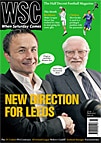 A return to terracing is on the agenda. Steve Menary explains what’s going on in Westminster
A return to terracing is on the agenda. Steve Menary explains what’s going on in Westminster
Could the government face an all-party rebellion over Sports Minister Richard Caborn’s refusal to countenance a return to standing at top-flight football matches? Seventeen years after the publication of the Taylor Report and after years when it was all but impossible to find a politician willing to propose a return to terracing, the mood at Westminster has changed.
At present, standing is barred in England’s top two divisions and promoted clubs get three years to comply with the law. But support for a rethink is growing and another “early day motion” asking for a debate on the issue has been put down in the House of Commons. This EDM is certainly not the first and, as such motions rarely succeed in winning an actual debate, it could be seen as pointless. Mike Hancock, the Lib Dem MP for Portsmouth South who put forward the latest motion, disagrees. He says: “I myself would prefer to stand at football matches – I am a regular at Fratton Park. Secondly, I am also aware of a large section of other regular supporters, of all clubs, who feel the same way. I see no reason whatever why sections of grounds, under proper supervision, could not be set aside for standing supporters.
“This would also relieve the tension between supporters and stewards when constant efforts have to be made to get people to sit down. It would also make life better for those supporters who wish to be seated, whether through choice or disabilities, who often have their view obscured by those who insist on standing, and who become angry or intimidated in the process.”
Well over 100 MPs, from SDLP and DUP members from Northern Ireland to arch Tory Ann Widdecombe and Labour stalwart Ann Cryer, have signed the EDM. Realising a debate is unlikely, many wrote to Caborn, too. In a reply to MP David Evennett, Caborn wrote: “I have discussed these issues directly with the football authorities including the Premier League, the Football Association and the Football league and they have told me in no uncertain terms that they support the all-seater policy and have no wish to see a return to standing. However, the government remain open to any new evidence that standing can be reintroduced in a safe and cost-effective manner.”
Neither Caborn nor the Football Licensing Authority (FLA) – the quango that enforces the law – will indicate what form this evidence should take, but two different campaigns are trying to solve this riddle. SAFE – Standing Areas For Eastlands – was started by Phill Gatenby of the Football Supporters’ Federation (FSF) to campaign for standing areas at Manchester City’s new ground. This failed but the baton has since been taken up more generally by the FSF. The other initiative, with a different agenda, is the Stand Up Sit Down (SUSD) campaign, started in 2005 by West Ham fans.
Gatenby explains: “The FSF calls for safe standing areas such as those seen in German stadiums. SUSD calls for standing areas within seated stands to be given over to those fans wishing to stand, to separate them from those fans wanting to remain seated or those who are physically unable to stand.” Steven Powell, FSF head of development, is working on a comprehensive report on the issue due out soon, while SUSD had input into a question in the forthcoming Football Fans Census of 2,000 football fans – half of them season-ticket holders – expected to show that 90 per cent favour separate standing areas.
How this would be achieved is the issue. Many fans, including the FSF, point to the German model, where 14,000 fans stand to watch Bundesliga matches but FLA chief executive officer John de Quidt believes this is impossible to implement here. He says: “The design of the German stadia is different. The main tier at the Allianz Arena, for example, is on the ground, but if you introduced standing in a cantilevered stand with a concourse underneath it would not be safe. If you just introduce standing in seating areas there would not be sufficient exits, either. People forget these technical issues. A high proportion of the new UK stadiums have been built for seating and if you went back to standing you would have to do a lot of work.”
That work would, of course, mean expensive remodelling of new stadiums that Premier League chairmen certainly could not stomach – unless the government forced them to. And that, with Richard Caborn as sports minister, is not going to happen.
From WSC 241 March 2007. What was happening this month